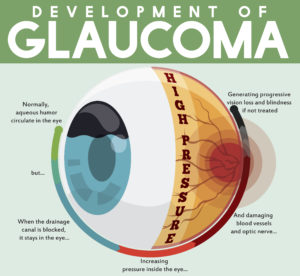January is National Glaucoma Awareness Month – An important time to raise awareness for this sight-robbing disease.
Glaucoma is an age-related disease and is the second leading cause of irreversible blindness in people over 40. Glaucoma is 6 to 8 times more common in African Americans than Caucasians. If you have a close blood relative with glaucoma, it raises your risk of getting it.
Glaucoma is the sneak thief of sight, since there are no symptoms and once vision is lost, it’s permanent. As much as 40% of vision can be lost without a person noticing.
More than 3 million people in the United States and over 60 million people worldwide, have glaucoma. Experts estimate that half of them don’t know they have it. Combined with our aging population, we can see an epidemic of blindness looming if we don’t raise awareness about the importance of regular eye examinations to preserve vision.
How to Help Raise Awareness
In the United States, approximately 120,000 are blind from glaucoma. Here are three ways you can help raise awareness:

- Talk to friends and family about glaucoma. Do not keep it a secret. Let your family members know.
- Get involved in your community, educational seminars, support groups, and more.
- Visit our website for more information on glaucoma at discoveryeye.org/eye-conditions/glaucoma/.
What is Glaucoma?
Glaucoma is a disease that causes damage to the major nerve of the eye called the op tic nerve, a part of the central nervous system that carries visual information from the eye to the brain.
tic nerve, a part of the central nervous system that carries visual information from the eye to the brain.
The eye experiences a gradual increase of intraocular pressure (IOP) due to an imbalance of the fluid produced in the eye and the amount of fluid drained. Over time, elevated IOP can cause vision loss. The most common form of glaucoma is primary open angle glaucoma which affects about 3 million Americans. However, there are other types including narrow angle, congenital, normal tension, and secondary glaucoma.
There is no cure for glaucoma—yet. However, medication or surgery can slow or prevent further vision loss. The appropriate treatment depends upon the type of glaucoma among other factors. Early detection is vital to stopping the progress of the disease.
Risk Factors
How do you know if you are at risk for glaucoma? Those at higher risk include people of African, Asian, and Hispanic descent. Other high-risk groups include: people over 60, family members of those already diagnosed, diabetics, and people who are severely nearsighted.
Regular eye exams are especially important for those at higher risk for glaucoma, and may help to prevent unnecessary vision loss. In the most common form, there are virtually no symptoms. Vision loss begins with peripheral or side vision, so if you have glaucoma, you may not notice anything until significant vision is lost.
Getting your eyes checked by an ophthalmologist regularly will be the best way to detect glaucoma or any other eye disease early.

